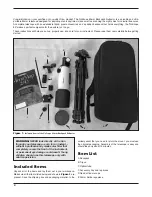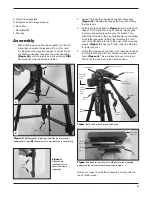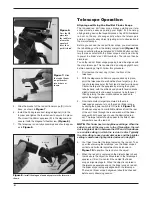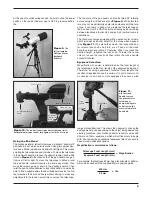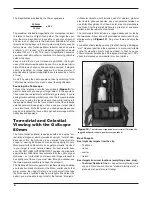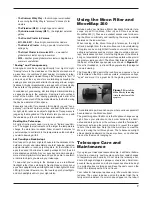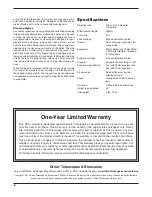
6
The magnification provided by the 10mm eyepiece is:
The maximum attainable magnification for a telescope is direct-
ly related to how much light it can gather. The larger the aper-
ture, the more magnification is possible. In general, a figure of
50x per inch of aperture is the maximum attainable for most
telescopes. Going beyond that will yield simply blurry, unsatis-
factory views. Your GoScope 80mm refractor has an aperture
of 80mm, or 3.1 inches, so the maximum magnification would
be about 155x (3.1 x 50). This level of magnification assumes
you have ideal atmospheric conditions for observing (which is
seldom the case).
Keep in mind that as you increase magnification, the bright-
ness of the object viewed will decrease; this is an inherent prin-
ciple of the laws of physics and cannot be avoided. If magnifi-
cation is doubled, an image appears four times dimmer. If
magnification is tripled, image brightness is reduced by a factor
of nine!
So start by using the 25mm eyepiece, then try switching to the
10mm eyepiece later if you want to boost the magnification.
Focusing the Telescope
To focus the telescope, turn the focus wheels (
Figure 8
) for-
ward or back until you see your target object in the eyepiece.
Then make finer adjustments until the image is sharp. If you’re
having trouble achieving initial focus, rack the focuser drawtube
all the way in using the focus wheels, then while looking into
the eyepiece slowly turn the focus wheels so that the drawtube
extends outward. Keep going until you see your target object
come into focus. Note that when you change eyepieces you
may have to adjust the focus a bit to get a sharp image with the
newly inserted eyepiece.
Terrestrial and Celestial
Viewing with the GoScope
80mm
The Orion GoScope 80mm is equipped with a 45-degree “cor-
rect-image” diagonal, which provides an upright, “normal” view.
Because of this, the GoScope is an excellent terrestrial tele-
scope for viewing Earth-based scenes during daylight hours.
More powerful than binoculars, it can get you visually “up close”
to your target for vivid, detailed views. For best results, how-
ever, DO NOT VIEW OUT WINDOWS. The glass in a window is
approximately 1000 times less accurate than the optics of your
GoScope – so it will soften your views, and things will seem to
be slightly out of focus. If you must view through a window, use
the lowest power available (and open the window!).
The GoScope 80mm also excels for nighttime viewing, enabling
you to see hundreds of craters on the Moon, Jupiter and its four
major moons, the rings of Saturn, and much more! If you take
the GoScope to a location away from city lights (the darker, the
better), you will be able to spot most of the famous “M objects,”
or Messier objects, which include open star clusters, globular
star clusters, gaseous nebulas, and even galaxies outside our
own Milky Way galaxy. You’ll need a star map or a planisphere
(the Orion Star Target plansiphere is a great one) and some
patience, but the rewards are endless.
The GoScope 80mm includes a rugged backpack for taking
the telescope, tripod, and all the included accessories with you
wherever you go (
Figure 12
). So get out there and enjoy the
views!
For astronomical viewing you may find that having a 90-degree
“star” diagonal positions the eyepiece at a more-comfortable
angle for viewing objects high overhead. In that case you
should consider purchasing a 90-degree star diagonal (1.25
"
);
check the telescope.com website for current options.
Best Targets
Best night sky targets from the city:
• The Moon
• Venus
• Jupiter
• Saturn
Best targets from rural locations (everything above, plus):
• The Great Nebula in Orion – a spectacular glowing cloud
of gas in Orion’s sword; this is a “stellar maternity ward,” a
place where new stars are forming.
Figure 12.
The telescope, tripod and accessories all fit inside the
rugged backpack, ready to go wherever you take it!
= 40x
400 mm
10 mm


